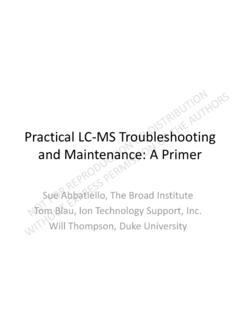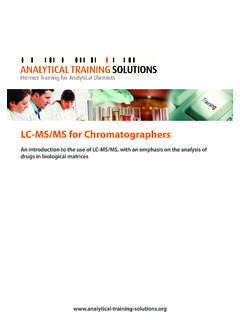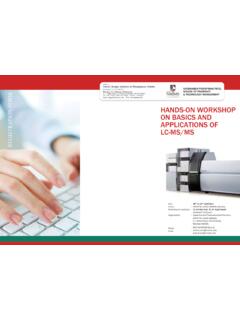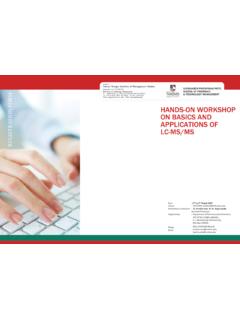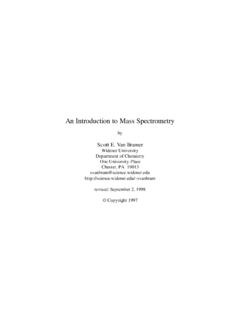Transcription of Fundamentals of Protein/Peptide Analyses by Mass …
1 Fundamentals of Protein and Peptide Analyses by mass spectrometry Arthur Moseley Genome Academy April, 2013 Workflows utilizing high-resolution high- mass accuracy LC-MS/MS Qualitative Protein Identification SDS-PAGE Gels Recombinant Expressed Purified Proteins Protein Interaction Networks Immunoprecipitations or Tagged-Protein Expression Systems Gel or Gel-Free protocols Qualitative or quantitative analysis (Label-Free or SILAC) PTM Characterization Phosphorylation (TiO2 Enrichments), S-Nitrosylation (RAC enrichments), Acetylation (Antibody Based Enrichment) Qualitative or Quantitative Analysis (Label-Free or various SILAC/covalent labeling strategies) Differential Protein Expression Analysis Global (non-targeted) quantitation of individual protein expression as a function of disease, treatment, time, etc.
2 A C B A Vs. Depletion and/or Selective Enrichment Depleted / Enriched Proteome Peptide and Protein Quantitation nanoscale UPLC MS Quantitative Pipeline Qualitative Pipeline Automated data transfer to NetApp enterprise data storage Integration of quantitative and qualitative data (Rosetta Elucidator) Automated translation to DB searchable format Waters PLGS, Rosetta Elucidator, Matrix Science Distiller Image Conversion, Image alignment and Quantitative Analysis (Rosetta Elucidator) Database search of product ion spectra (Waters IdentityE and Matrix Science Mascot) Peptide ID quality scoring & translating peptides to proteins (Rosetta Elucidator or Proteome Software s Scaffold) MSE or MS/MS Analytical Focus is Most Often Directed to Sample Analysis, but Efficient and Reproducible Sample Prep is Essential DIGEST High resolution , Accurate mass mass spectrometry High Resolution Accurate mass Measurements Precursor Ions and Product Ions Sample (lysate, sub-cellular fraction) Differential Protein Expression Analysis Label-Free Quantitation Workflow Retention Time Retention Time m/z Retention Time m/z Master Image Retention Time Intensity Isotope Group Image Translation Retention Time Alignment Intensity Normalization Condition 1 Condition 3 Condition 2 Condition 4 m/z Retention Time.
3 (n=12) Solubilize and Process Protein 1D- or 2D- LC-MS Rigorously use Quantitatively Reproducible Analytical Methods Forget not the basics of analytical chemistry Highly reproducible chromatography is required A high sampling rate across the chromatographic peak is required for accurate quantitation Ideally want 15-20 sampling points across chromatographic profile Highly reproducible chromatography is required for sample-to-sample comparisons High resolution, accurate mass (precursor & products) tandem mass spectrometry technology needed For quantitative selectivity (near isobaric cross-talk) For accurate qualitative identifications 1% FPR at peptide level (Decoy DB; Peptide Prophet) No QCs = No Quantifiably Reliable Data No Replication = No Quantifiably Reliable Data No Common Standard = No Meaningful Comparison across Projects Selected Ion Chromatograms - area/volume are the quantitative measure Peptide Quantity Sum of all features from that peptide Protein Quantity Sum of all peptides from that protein Quantitation of a peptide Across four biological groups Peptide CV = 8 - 12% Protein CV = 3 - 4% Analytical Variability of ~ 35,000 peptides Daily QC Sample (pool of QC plasma sample)
4 Analytical + Biological Variability of ~35,000 peptides Patient Samples 25% CV Plasma peptides ~ 40% Isotope Groups CV < 10% ~ 70% Isotope Groups CV < 20% ~ 90% Isotope Groups CV < 25% ~ 2 % Isotope Groups CV < 25% Injection Incorporation of Qualitative Identifications and Protein Quantitation Peptide Quantity Sum of all features from that peptide Protein Quantity Sum of all peptides from that protein Intensity Forward/Reverse Database Mascot IdentityE PeptideTeller algorithm to yield peptide level 1% FDR m/z Export Peak List Import Search Results Retention Time Retention Time Intensity Number of Analytes Number of Samples 1,000s-10,000s 10s 10-100 100 -1,000 10 1,000s Plasma, Tissue, Proximal Fluids, etc. Differential Protein Expression Analysis Increasing the Depth of Coverage in a Discovery Experiment * Maintain Quantitative Precision * Incorporate into Label- Free Workflow * Keep Analysis Time and Cost Low * Improve Qualitative Depth of Coverage * Improve Confidence in Spectral Assignments Current Want Need * Ion-Mobility Enabled Data-Independent Acquisitions * Multidimensional LC Separations Ion-Mobility Enabled Data-Independent Acquisitions Ion mobility PLGS Software Differential Protein Expression Analysis Label-Free Quantitation Workflow Multidimensional LC Image Translation Retention Time Alignment Intensity Normalization Condition 1 Condition 3 Condition 2 Condition 4 m/z Retention Time.
5 (n=8) Condition 1 Condition 3 Condition 4 Condition 2 Fraction 1 ..(n=3) Fxn 1 Fxn 2 Fxn 3 m/z Retention Time Retention Time Retention Time Injection Peptide Quantity Sum of all features from that peptide (all fractions) Protein Quantity Sum of all peptides from that protein Intensity RP/RP Multidimensional Liquid Chromatography First Dimension Reverse Phase Separation, pH 10 300 um x 5 cm column 5um XBridge C18 particles Second Dimension Reverse Phase Separation, pH 75 um x 15 cm column BEH130 C18 particles Key Advantages High orthogonality High resolution Excellent reproducibility Low sample requirements (~3 ug for 5- fraction, ~5 ug for 10-fraction) NanoAcquity UPLC System with 2D Technology um BEH130 C18 75 um x 15 cm A: 20 mM Ammonium Formate, pH 10 B: Neat ACN A: B: 5 um Xbridge C18 300 um x 5 cm 0102030405060708090010203040506070809005 0100150200250300%B 1st Dimension %B 2nd Dimension Minutes Increased Coverage from 2D RP/RP Fractionation Experimental Design Triplicate Analysis 1 ug Ecoli Lysate Investigator supplied pellet Rapigest/sonication in 50 mM ammonium bicarbonate 1D LC Separation 90 min gradient um BEH130 C18 75 um x 25 cm UPLC column 2D LC Separation 5-fraction and 10-fraction Synapt G2 HDMS Resolution Mode IM-DIA LE Scan, HE Scan HE Scan: 27V 50V CE Ramp Spectra Processed/Searched in PLGS ( ) (100% FDR) Import spectra to Scaffold ( ) (Proteome Software) Peptide Prophet Algorithm (Keller, A et.)
6 Al. Achem. 2002, 74.) Fxn 1 Fxn 2 Fxn 3 Fxn 4 Fxn 5 Equal Distribution of peptides Across Fractions Average Identifications Average Cumulative Identifications 5-Fraction LC/LC 12345678910 Cumulative Identifications Identified peptides 1st Dimension Fraction 12345 Cumulative Identifications Identified peptides 1st Dimension Fraction Average Identifications Average Cumulative Identifications 10-Fraction LC/LC 4269 15318 27072 90-min 1D5fxn LC/LC10fxn LC/LCIdentifications Increased Depth of Coverage 2D LC/LC < Peptide Level False Discovery Rate (Scaffold) 73% 3/3 74% 3/3` 78% 3/3 568/1449 1D 1016/1449 5 fxn 1422/1449 10 fxn 568 1016 1422 90-min 1D5fxn LC/LC10fxn LC/LCIdentifications + fold + fold + fold + fold 88% 2/3 86% 2/3 85% 2/3 Protein Overlap 90 min 1D Protein Overlap 5fxn 2D Protein Overlap 10fxn 2D Protein Identifications Peptide Identifications Assessing the Analytical Reproducibility in a Multidimensional LC/LC-MS Experiment n= 17 n= 16 Pre-Treatment Needle Biopsy Tumor Samples Post-Treatment Needle Biopsy Tumor Samples Solubilize Reduce/alkylate/trypsin digest Biological Rep 1 2 3 4 5 6 5-Fraction 2D UPLC/UPLC Synapt G2 Resolution Mode IM-DIA Rosetta Elucidator Label-Free Quantitation Peptide Teller Annotation (1% FDR) Molecular Weight M Assessing Analytical Reproducibility Incorporating Quality Controls QC 1.
7 Yeast ADH spiked into each sample at a constant fmol quantity per ug of lysate QC 2: create a pooled sample from equal portions of all samples and run (same analytical method) periodically throughout the study Day 1 Injection 1 Day 9 Injection 42 QC pool run periodically throughout study Individual biological (randomized) replicates with spiked yeast ADH run in singlicate Global Protein Expression Profiles Principle Component Analysis Protein Level (n=1278) 36/40 samples (4 outliers removed) Z-score normalized Agglomerative Cluster Protein Level (n=1278) 36/40 samples (4 outliers removed) Z-score normalized Proteins (n=1278) Intensity Coefficient of Variation Distributions 7 QC pool injections over 9 days of data acquisition 0%20%40%60%80%100%0501001502002503003504 004505152535455565758595 MoreCumulative % Frequency Coefficient of Variation % (bins of 5%) Average CV: Median CV.
8 80% of the signals have CVs < 50% of the signals have CVs < Average CV: Median CV: 80% of the signals have CVs < 50% of the signals have CVs < 0%20%40%60%80%100%0200400600800100012001 4001600180020005152535455565758595 MoreCumulative % Frequency Coefficient of Variation % (bins of 5%) Protein (n=1278) peptides (n=6024) Analytical Variation Across Dynamic Range + + + + + +07%CV Peptide Intensity Log10 Summed Peptide Intensity + + + + + + +08%CV Protein Intensity Log10 Summed Protein Intensity Peptide Level (n=6024) Individual peptide Average for that order of magnitude Protein Level (n=1278) Individual protein Average for that order of magnitude Tandem mass spectrometry (MS/MS) for Peptide Identification mass Spectrometer Tandem mass Spectrometer Tandem MS permits selection and isolation of specific ions for subsequent analysis.
9 Tandem instruments have multiple mass analyzers. Synonyms - Tandem mass spectrometer - MS/MS Fundamentals of MS/MS for Peptide ID 1. Precursor ions are selected and isolated 2. Collision-Induced-Dissociation results in fragmentation 3. Product Ions are characterized with the second mass analyzer Q1 Q2 Q3 mass FILTER RF ONLY mass FILTER PRECURSOR ION SELECTION NEUTRAL GAS COLLISIONS PRODUCT ION DETECTION ION SOURCE DETECTOR Quadrupole/Time-of-Flight Tandem mass Spectrometer REFLECTRONSKIMMERSAMPLING CONEZSPRAY Ion SourceQUADRUPOLE IN NARROW BANDPASS MODE Q - TOFMS/MS MODEHEXAPOLE GAS COLLISION CELLDETECTORPUSHERTOFRF HEXAPOLERF HEXAPOLETMC ommon Peptide Product Ion Types - fortunately, peptide fragment in predictable locations along the peptide backbone NH2_ CH_ CO_ NH_ CH_ CO_ NH_ CH_ NH_ CH_ CO_ NH_ CH_ CO2HR1R2R3Rn+2 Hcn-1z1+2 Hbn-1y1an-1x1+2 Hcn-2z2c2+2 Hzn-2c1+2 Hzn-1b2+2 Hyn-2a2xn-2b1+2 Hyn-1a1xn-1Rn-1K.
10 Biemann in Methods in Enzymology, 1990, 193, p. 886-887 MS/MS Spectrumof Doubly Charged Glu-Fibrinopeptide: y-series ions 1002003004005006007008009001000110012001 300140015001600M/ z0100%Glu f ib 50 uL of uMqt07123 AccMass 75 (Cen,2, , Ar, , )2: TOF MSMS + R A S F F G E E N D N V ( ) y Ma **Remember, y-ions read C->N direction **Last y ion (y14) = peptide M+H+ Overview of Peptide Identification Peptide Molecular Weight - mass accuracy very important - Experimental MW compared with peptide MWs from in-silico digestion of proteome database - Generate list of MW matching (+/- mass error) Peptide Fragment MW - mass accuracy very important - Experimental fragment MW compared with MWs from in-silico fragmentation of peptides from list Search Engines for Interpreting Peptide MS/MS Spectra Mascot MS-Tag (Protein Prospector) Omssa PepFrag (Prowl) pFind Phenyx Sonar (Knexus) X!
